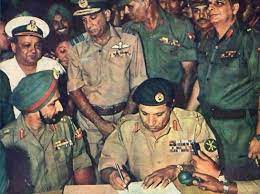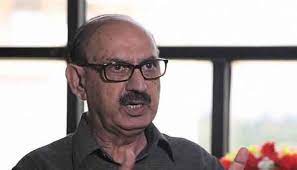In his final public statement as Pakistan’s Chief of Army Staff (COAS), Gen Qamar Javed Bajwa stated that “the number of soldiers fighting [in erstwhile East Pakistan] was not 92,000 but 34,000.” He added, “These 34,000 soldiers were confronted by an Indian army of 250,000 soldiers and 200,000 members of the Mukti Bahini. Against these heavy odds, our army fought bravely and gave exemplary sacrifices which were acknowledged by Indian Army Chief Field Marshal Manekshaw.”
His statement immensely irked India. Each year, India celebrates Swarni Vijay Parv (golden-victory festival) to commemorate its “victory” against Pakistan in the 1971 Indo-Pak War. India’s Defence inister Rajnath Singh said that this victory is even greater than the two world wars fought. It was “the most decisive” as the “Indian Armed Forces in the 1971 War changed the history and geography of South Asia.” The Tribune reported “India rightly claims credit for her ‘politico-military midwife’ role in the creation of an independent Bengali-speaking state in 1971. Rajnath Singh also claimed, “India’s partition on religious grounds was a ‘historic mistake’’ He added “India has never invaded any country, nor has it ever captured an inch of the land of any other country.” He lies.
True, in a war the truth is the first casualty. The truth about the casualties, strength of the Pak forces, and several other aspects is well exposed by Sarmila Bose in her book DEAD RECKONING — Memories of the 1971 Bangladesh War. Bose says, ‘Many facts had been exaggerated, fabricated, distorted or concealed. Many people in responsible positions had repeated unsupported assertions without a thought; some people seemed to know that the nationalist mythologies were false and yet had done nothing to inform the public. I had thought I would be chronicling the details of the story of 1971 with which I had been brought up, but I found instead that there was a different story to be told’.
She points out that Mujeebur Rehman’s landslide electoral victory did not certify people’s desire to secede from Pakistan. She suggests that the people voted for Mujeeb as they were alienated by neglect of their welfare by the then government. In any case, a huge chunk of the population, over 40 percent, did not vote. They certainly were not enamoured of Mujeeb’s tactics.
Bose examines specific incidents of violence across East Pakistan from about January 1971 until March 1972. She gives eyewitness accounts of the survivors of the incidents as well as the accounts of the kin of those killed, and of the Pakistan Army officers who had served in East Pakistan at that time. She approaches the subject with the élan of a journalist and the seriousness of an academic.
She discredits the Indian and Bangladeshi claim that the Pakistani Army committed genocide of three million Bengalis. She calls it the “ultimate word-number combination” and a “gigantic rumour”. She deflates the figure to between 50,000 and 100,000. It is not unusual to play with numbers of vested interests. For instance, there is a lot of confusion about the numbers of Jews killed in the Holocaust.
Bose questions the figures like 300,000 deaths of Bengalis and 200,000 rapes of Bengali women. She says that there were more villains and one cannot single out the Pakistan Army in the whole episode of violence which resulted in the creation of Bangladesh. Indian involvement, Bengali forces and Sheikh Mujibur Rehman were equally responsible. She has questioned the figure of 93,000 prisoners of war in Indian custody, when the total Army was not 93,000 in East Pakistan. She has challenged the facts with the records; she had conducted the interviews of people who lived the war.
She highlights individual acts of kindness of Pakistani soldiers, narrating them with poignancy. She shrugs off generalisations about or “demonisation” of rivals epitomized by “Shaala Panjabi” or “Khan sena”.
India’ role in stoking insurgency is obvious. To tarnish Pakistan’s image India has propagated many myths. Some of these myths have been exploded by Sarmila Bose and Praveen Swami. India officially authorised invasion of East Pakistan. Yet it was not declared an aggressor by the United Nations.
At 11.15 pm on 14 December 1971, Indian Air Force pilots bombed the Government House, Dacca. At that time, East Pakistan’s Cabinet had begun an emergency meeting to discuss the political measures to avoid the looming surrender of their army at Dacca. A.M. Malik, head of the then East Pakistan government, survived the bombing along with his Cabinet, but resigned.
India’s Chief of Army Staff issued a secret order to the General Officer Commanding, Eastern Command, intimating the campaign that would end with the dismemberment of Pakistan.
The Eastern Command was to ensure that the guerrilla forces were to work towards “tying down the Pak [Pakistan] Military forces in protective tasks in East Bengal,” “sap and corrode the morale of the Pak forces in the Eastern theatre and simultaneously to impair their logistic capability for undertaking any offensive against Assam and West Bengal,” and, finally, be used along with the regular Indian troops “in the event of Pakistan initiating hostilities against us” (Praveen Swami, India’s secret war in Bangladesh, The Frontline, 26 December 2011).
Field Marshal Manekshaw makes no bones in a YouTube interview that Indira Gandhi compelled him to attack East Pakistan; He initially delayed the attack in view of the impending monsoon. But he later complied with her order. He admitted “The Pakistani forces fought extremely well”.
In a published letter, RAW officer R KYadav made a startling revelation that India’s prime minister Indira Gandhi, parliament, RAW and the armed forces acted in tandem to dismember Pakistan’s eastern wing. The confessions in his letter are corroborated by B. Raman’s book The Kaoboys of R&AW. He reminds `Indian parliament passed resolution on March 31, 1971 to support insurgency. Indira Gandhi had then confided with Kao that in case Mujib was prevented from ruling Pakistan, she would liberate East Pakistan from the clutches of the military junta. Kao, through one RAW agent, got a Fokker Friendship, the Ganga, of Indian Airlines hijacked from Srinagar to Lahore. Indian army chief Manekshaw initially refused to carry out Indira Gandhi’s order because of the impending monsoon when rivers flooded in East Pakistan and troops’ movement became difficult. Not only intelligence officers but also officers of armed forces are employed to carry out subversion and sabotage inside Pakistan.
There are several other myths and bitter truths (exposed by Sarmila Bose and others) about the 1971 War. Take the Jesssore massacre. “It turns out that the massacre in Jessore may have been genocide, but it wasn’t committed by the Pakistan Army. The dead men were non-Bengali residents of Jessore, butchered in broad daylight by Bengali nationalists“ (Sarmila Bose, from her article “The Truth About The Jessore Massacre” published in The Telegraph on 19 March 2006
India’s renowned investigative journalist Praveen Swami writes, ‘The role of irregular forces, though, needs a more nuanced assessment. … They were also, however, responsible for large-scale human rights abuses targeting Pakistani sympathisers and the ethnic Bihari population. There is no moral equivalence between these crimes and those of the Pakistani armed forces in 1971, but the fact also is that the irregular forces bequeathed to Bangladesh a militarised political culture that would have deadly consequences of its own’.
Sarmila Bose writes, ‘Many Bengalis, supposed to be fighting for freedom and dignity, committed appalling atrocities; many Pakistani Army officers, carrying out a military action against a political rebellion, turned out to be fine men doing their best to fight an unconventional war within the conventions of warfare.
The Bengalis splintered into many fragments, those who wanted an independent Bangladesh, those who supported a united Pakistan, those who desired autonomy but not secession, those who actively fought for whichever side they supported and those who like Doctor Zhivago wanted to ‘just live’ but got caught up in the upheaval nevertheless. There were combatants and non-combatants, victims of violence and its perpetrators’.
India’ role in stoking insurgency is obvious. To tarnish Pakistan’s image India has propagated many myths. Some of these myths have been exploded by Sarmila Bose and Praveen Swami. India officially authorised invasion of East Pakistan. Yet it was not declared an aggressor by the United Nations.
The situation in occupied Kashmir is worse than it was in East Pakistan (custodial deaths, fake encounters, rapes, arson, and so on). Even children and women are rounded up and held incognito during cordon-and-search operations. Pakistan is a convenient scapegoat to blame for indigenous insurgency. Orphaned Kashmiri babies are being sold in Indian states. To destroy traditional Kashmir shawl industry, pashmina wool is being exported from Ladakh to Uttar Pradesh.























